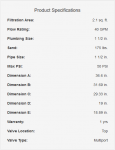We're looking to replace our noisy pump, but I wanted to make sure I'm sizing the potential replacement right. Our filter is this one:


So it looks like it's rated at 40GPM. Does this mean the pump has to be 40GPM or less? If so, it seems to limit my options somewhat. There seems to be one Hayward pump (SP1540C), and that's about all I can find.
The pump that's going to be replaced is 1.5HP, and rated at 83GPM according to the manual. I'm very surprised at that. It seems to exceed what the filter is rated for.
Any help/advice would be greatly received. Thanks!


So it looks like it's rated at 40GPM. Does this mean the pump has to be 40GPM or less? If so, it seems to limit my options somewhat. There seems to be one Hayward pump (SP1540C), and that's about all I can find.
The pump that's going to be replaced is 1.5HP, and rated at 83GPM according to the manual. I'm very surprised at that. It seems to exceed what the filter is rated for.
Any help/advice would be greatly received. Thanks!


